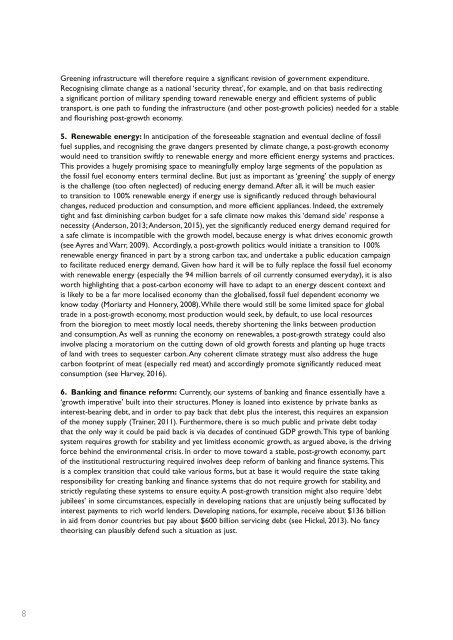peerreviewed Fellow
MSSI-IssuesPaper-6_Alexander_2016
MSSI-IssuesPaper-6_Alexander_2016
You also want an ePaper? Increase the reach of your titles
YUMPU automatically turns print PDFs into web optimized ePapers that Google loves.
Greening infrastructure will therefore require a significant revision of government expenditure.<br />
Recognising climate change as a national ‘security threat’, for example, and on that basis redirecting<br />
a significant portion of military spending toward renewable energy and efficient systems of public<br />
transport, is one path to funding the infrastructure (and other post-growth policies) needed for a stable<br />
and flourishing post-growth economy.<br />
5. Renewable energy: In anticipation of the foreseeable stagnation and eventual decline of fossil<br />
fuel supplies, and recognising the grave dangers presented by climate change, a post-growth economy<br />
would need to transition swiftly to renewable energy and more efficient energy systems and practices.<br />
This provides a hugely promising space to meaningfully employ large segments of the population as<br />
the fossil fuel economy enters terminal decline. But just as important as ‘greening’ the supply of energy<br />
is the challenge (too often neglected) of reducing energy demand. After all, it will be much easier<br />
to transition to 100% renewable energy if energy use is significantly reduced through behavioural<br />
changes, reduced production and consumption, and more efficient appliances. Indeed, the extremely<br />
tight and fast diminishing carbon budget for a safe climate now makes this ‘demand side’ response a<br />
necessity (Anderson, 2013; Anderson, 2015), yet the significantly reduced energy demand required for<br />
a safe climate is incompatible with the growth model, because energy is what drives economic growth<br />
(see Ayres and Warr, 2009). Accordingly, a post-growth politics would initiate a transition to 100%<br />
renewable energy financed in part by a strong carbon tax, and undertake a public education campaign<br />
to facilitate reduced energy demand. Given how hard it will be to fully replace the fossil fuel economy<br />
with renewable energy (especially the 94 million barrels of oil currently consumed everyday), it is also<br />
worth highlighting that a post-carbon economy will have to adapt to an energy descent context and<br />
is likely to be a far more localised economy than the globalised, fossil fuel dependent economy we<br />
know today (Moriarty and Honnery, 2008). While there would still be some limited space for global<br />
trade in a post-growth economy, most production would seek, by default, to use local resources<br />
from the bioregion to meet mostly local needs, thereby shortening the links between production<br />
and consumption. As well as running the economy on renewables, a post-growth strategy could also<br />
involve placing a moratorium on the cutting down of old growth forests and planting up huge tracts<br />
of land with trees to sequester carbon. Any coherent climate strategy must also address the huge<br />
carbon footprint of meat (especially red meat) and accordingly promote significantly reduced meat<br />
consumption (see Harvey, 2016).<br />
6. Banking and finance reform: Currently, our systems of banking and finance essentially have a<br />
‘growth imperative’ built into their structures. Money is loaned into existence by private banks as<br />
interest-bearing debt, and in order to pay back that debt plus the interest, this requires an expansion<br />
of the money supply (Trainer, 2011). Furthermore, there is so much public and private debt today<br />
that the only way it could be paid back is via decades of continued GDP growth. This type of banking<br />
system requires growth for stability and yet limitless economic growth, as argued above, is the driving<br />
force behind the environmental crisis. In order to move toward a stable, post-growth economy, part<br />
of the institutional restructuring required involves deep reform of banking and finance systems. This<br />
is a complex transition that could take various forms, but at base it would require the state taking<br />
responsibility for creating banking and finance systems that do not require growth for stability, and<br />
strictly regulating these systems to ensure equity. A post-growth transition might also require ‘debt<br />
jubilees’ in some circumstances, especially in developing nations that are unjustly being suffocated by<br />
interest payments to rich world lenders. Developing nations, for example, receive about $136 billion<br />
in aid from donor countries but pay about $600 billion servicing debt (see Hickel, 2013). No fancy<br />
theorising can plausibly defend such a situation as just.<br />
8


